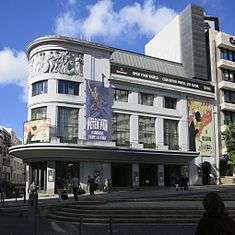Rivoli Theatre (Portugal)
| Rivoli Theatre (Teatro Rivoli) | |
| National Theatre of Porto, Municipal Theatre of Porto | |
| Theater (Teatro) | |
The modernist architecture situated on the corner Praça de D. João I and Rua do Doutor Magalhães Lemos | |
| Official name: Teatro Rivoli/Teatro Nacional | |
| Country | |
|---|---|
| Region | Norte |
| Subregion | Greater Porto |
| District | Porto |
| Municipality | Porto |
| Location | Cedofeita, Santo Ildefonso, Sé, Miragaia, São Nicolau e Vitória |
| - coordinates | 41°8′51.92″N 8°36′34.73″W / 41.1477556°N 8.6096472°WCoordinates: 41°8′51.92″N 8°36′34.73″W / 41.1477556°N 8.6096472°W |
| Architect | Júlio José de Brito, Pedro Ramalho |
| Style | Art Deco |
| Materials | Brick masonry, Reinforced concrete, Iron, Wood, Marble |
| Owner | Câmara Municipal do Porto |
| For public | Public |
| Easiest access | Praça de D. João I; Rua do Doutor Magalhães Lemos |
| Management | Instituto Gestão do Patrimonio Arquitectónico e Arqueológico |
| Operator | Câmara Municipal do Porto |
| Listing | Included in the Historic Centre of the City of Porto (PT011312140163) and Historic Zone of the City of Porto (PT011312070086) |
| Wikimedia Commons: Teatro Rivoli | |
| Website: www | |
The Rivoli Theatre is a Portuguese theatre and concert venue in civil parish of Cedofeita, Santo Ildefonso, Sé, Miragaia, São Nicolau e Vitória, in the municipality of Porto, in northern Portugal.
History
_dirige_L._v._Beethoven_Sinfonia_N.9.jpg)

The National Theatre was inaugurated on 5 October 1913.[1] Its first property-owner was the merchant Manuel Pires Fernandes.[1] The coliseum reached its zenith under the management of D. Maria Fernandes Borges, daughter of the owner, who lived in the house alongside the theatre, with a direct passage to the building.[1]
From 1926, its program of events included theatre, opera and concerts (but also exhibitions of some popular film), and at this time its name had been substituted in the publicity as the Rivoli.[1] Restoration work at the theatre began in 1928, when they began to exhibit films of higher acoustic quality, normally associated with events with specialized voices.[1]
In the course of the city's urban renewal, in 1932, the immense building (which occupied a large block) was included in the re-purposing of space, thereby reducing its footprint: part of its area was occupied by a branch of the Caixa Geral de Depósitos.[1] The project director altered the theatre's elevation and facade (in 1940), with the installation of the existent base relief sculpture in order to better integrate with the re-created D. João I Square.[1] But, by 1942, the space was once again the attention of intervention; the interiors were remodelled, obtaining new furniture and interior decoration during the mid-century.[1] This work included placement of new flooring and staircases in marble, more comfortable furniture in the hall and balcony, installation of a cloakroom and illuminated displays, lightly painted halls, decoration of the buffets, new armchairs and sofas, and an electric refrigeration system.[1]
In the 1960s, the Rivoli lived a period of intense attention, with cultural activities realized at the site, including various concerts by personalities of national and international renowned.[1]
Between 1970 and 1980, under the management of movie distributors Castello Lopes Cinemas, the quality of events decreased, and by 1974, it was principally used to exhibit pornographic films.[1] It eventually began to be managed by the Banco Português do Atlântico (in 1989), but was purchased by the municipal authority of Porto, who acquired the building for 480.000 contos, a structure that already showed its age, with obsolete equipment and dated interiors.[1]
In 1994, the building suffered a profound remodelling, that includes altering its capacity and rethinking its cultural importance.[1] On 16 October 1997, the building was re-inaugurated, with updated, modern infrastructures in auditorium (which included a 60,000 euro lowering of the stage), practice rooms, reception and food areas.
As 2015, the Rivoli Theatre is the de facto municipal theatre of Porto (Portuguese: Teatro Municipal do Porto), managed by Culturporto.[1]
Architecture
The theatre is situated at the heart of city, flanked in the west and north by the Caixa Geral de Depósitos, on the corner of Praça de D. João I and Rua Dr. Magalhães Lemos, integrated harmoniously between the building.[1]
References
Notes
Sources
- Panorama (in Portuguese) (5–6), 1941
- Fernandes, José Manuel (1995), Cinemas de Portugal (in Portuguese), Lisbon, Portugal
- Tostões, Ana; Lacerda, Manuel; Soromenho, Miguel, eds. (2004), Arquitectura Moderna Portuguesa 1920 - 1970. Um Património a Conhecer e Salvaguardar (in Portuguese), Lisbon, Portugal: IPPAR
- Nadais, Inês (15 January 2015), "Teatro Municipal do Porto reabre dia 23 para fazer uma "idade feliz"", Público (in Portuguese), p. 26